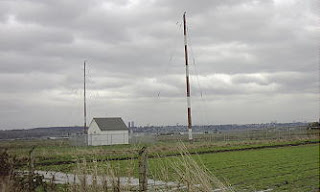 Hunting For NDB’s In CLE 210
Hunting For NDB’s In CLE 210
 |
| 'VR' - 266kHz |
This coming weekend will see another CLE challenge, this time in the MF band from 260 - 269.9 kHz plus 440 - 1740 kHz.
'CLE's' are 'Co-ordinated Listening Events', and NDB DXers around the world focus their listening time on one small slice of the NDB spectrum ... but this time around, the range has been expanded.
The lower frequency range covers one my very strong locals, 'VR' on 266 kHz. 'VR' is an outer marker approach to Vancouver International's 'two-sixes' and is located a few miles east of the main runways in a farmer's field. Although running just 50 watts, it is widely reported (as far east as North Carolina), probably due to the excellent soggy ground beneath its somewhat unusual delta-shaped loop.
From CLE coordinator Brian Keyte (G3SIA), via the Yahoo ndblist Group, comes the following reminder:
Hello all,
Our end-of-August Co-ordinated Listening Event will soon be here.
We'll be hunting for normal beacons in two contrasting frequency ranges
and there is also the possibility of hearing several amateur beacons.
As always, first-time CLE logs will be extra welcome.
Days: Friday 26 August - Monday 29 August
Times: Start and end at midday, your local time
Frequencies: 260.0 - 269.9 kHz
plus: 440.0 - 1740.0 kHz
These are interesting frequencies, the same ones that we last used for
CLE191 in February 2015 when 45 of us joined in.
Many of us should be able to hear beacons in both ranges, though Europe
only has a handful in the '260s'. From 440 onwards, North America has a
few, mostly around 520 kHz, while Eastern Europe has several beacons
and some regular UNIDs. Some of the NDBs can also be found among
Europe's Medium Wave Broadcast Stations.
Many of us are within range of amateur beacons on frequencies mainly
around 474 - 478 kHz. We'll be listening for ANYTHING OPERATING IN
BEACON MODE, preferably with normal speed Morse.
(We ask operators who sometimes use QRSS, PSK, WSPR, etc.,
which need software to receive them, to PLEASE CHOOSE THE
SIMPLER MODE during the CLE so that we shall all be able to
receive them and make reports).
Please look out for my final details with advice about log-making, etc.
in a few days.
73
Brian
----------------------------------------------------------
From: Brian Keyte G3SIA ndbcle'at'gmail.com
Location: Surrey, SE England (CLE co-ordinator)
----------------------------------------------------------
These listening events serve several purposes. They:
- determine, worldwide, which beacons are actually in service and on-the-air so the online database can be kept up-to-date
- determine, worldwide, which beacons are out-of-service or have gone silent since the last CLE covering this range
- will indicate the state of propagation conditions at the various participant locations
- will give you an indication of how well your LF/MF receiving system is working
- give participants a fun yet challenging activity to keep their listening skills honed
Final details can be found at the NDB List website, and worldwide results, for every participant, will be posted there a few days after the event. If you are a member of the ndblist Group, results will also be e-mailed and posted there.
The very active Yahoo ndblist Group is a great place to learn more about the 'Art of NDB DXing' or to meet other listeners in your region. There is a lot of good information available there and new members are always very welcome. As well, you can follow the results of other CLE participants from night to night as propagation is always an active topic of discussion.
If you are contemplating getting started on 630m, listening for NDBs is an excellent way to test out your receive capabilities as there are several NDBs located near this part of the spectrum.
You need not be an ndblist member to participate in the CLEs and all reports, no matter how small, are of much value to the organizers. 'First-time' logs are always VERY welcome!
Reports may be sent to the ndblist or e-mailed to either myself or CLE co- ordinator, Brian Keyte (G3SIA), whose address appears above.
Please ... give the CLE a try ... then let us know what NDB's can be heard from your location! Your report can then be added to the worldwide database to help keep it up-to-date.













Thanks for the warning, Steve. I’ll be participating in earnest, this time. Let’s just hope the conditions favourable to us.
OK, i’m interested…. using a icom 718 and a 160-10 dipole ant. What mode should i be using and will HRD software decode or print the results?
tns es gud dx
Walt…best to use CW mode on receive as ndbs repeat their IDs about every 6 seconds. I’m not familiar with the HRD software.
Steve
Hi Steve. Just a note to say that I am running a CW beacon at 12 wpm on 475.2 kHz this weekend. There might be a few pauses when I want to check for some MF activity from time to time in the evenings.
Hope to hear from some of the listeners.
73
Neil Klagge
Hi Steve,
Just a heads up, we are transmitting on 75KHz at .075040 USB using WSPR
curious to see if you might be able to spot my signal.
We transmit 24-7 provided the Arizona Monsoon season does not shut us down.
73,
Ron Douglass NI7J/WH2XND
Phoenix, AZ